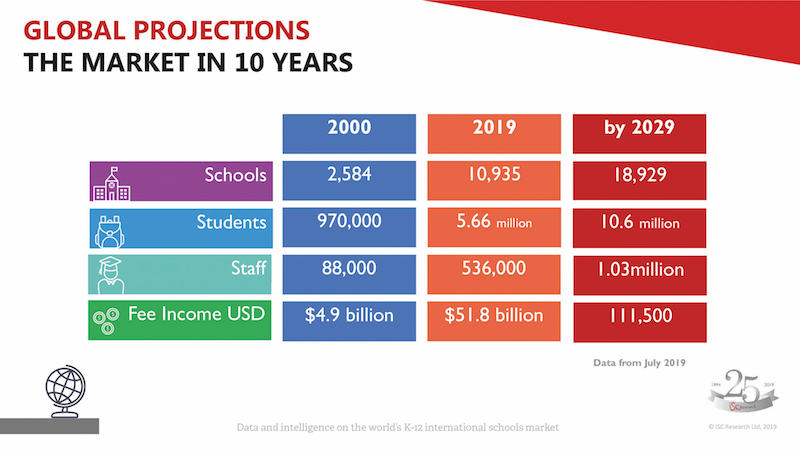Where have all the teachers gone?
Posted on 19th Feb 2020 in International School, International Education, Teaching
Liz Free identifies a concerning trend from latest international education snapshots...
My eight-year-old daughter has discovered the potential of Alexa in all her glory! It appears that ‘True Colours’ (the Joshua Radin version, interestingly) and ‘Where Have all the Flowers Gone?’ are the hits to behold, and the lyrics of both have been ruminating for days as they echo around our home. When Pete Seger wrote the lyrics to the latter in 1955, who would have thought that 65 years later they would be so loved and embraced as if they had never been heard before? The sentiments of Seger’s lyrics run deep; particularly since I returned from speaking at the October 2019 Alliance for International Education conference in Geneva, the familiar lyrics are morphing into ‘where have all the teachers gone?’ A convenient analogy perfectly timed – or, perhaps, it’s the perfect fit?
It was a pleasure to co-present in Geneva with Nalini Cook, Head of Europe Research and Schools Relations Manager, ISC Research, as we explored the trends and challenges of international education, its value and its relevance. Nalini’s presentation focussed on the latest data and, as the big and scary numbers appeared, one after the other, we all sat aghast. Perhaps the biggest and scariest of these, ignoring the value of the market, was the number of staff required to service the projected growth demand. Although we’ve seen these figures coming, they still shock me.
If this data holds true (and historically ISC have been rather accurate in their projections), in the next ten years we will see an increase in demand for staff in international schools from 536 thousand to 1.03 million. This is unprecedented growth and begs the question: where will they all come from? As I love a bit of data surfing, tackling such a question requires digging into the numbers! Let’s start with the traditional suppliers for English-medium international education: how big is this pool? These are the fulltime equivalent numbers in the following countries:
- 506,400 in the UK (BESA, 2019)
- 3,600,000 in the USA (Nces.ed.gov, 2019)
- 282,000 in Australia (Acara.edu.au, 2019)
- 67,403 in Ireland (Education.ie, 2019)
This makes an impressive pool of 4,455,803. Essentially, that means that if we continue the traditional approach of recruiting expatriate native English-speaking teachers from these countries, we would require about one in every four of them to work in the international sector each year. Ignoring the financial, social, moral and ethical issues around this situation, why wouldn’t this work?

Well, the teachers quite simply aren’t there. And ‘where have all the teachers gone?’ I hear you ask. A 2019 Teachaway report identified that there is a global shortage of teachers and that the ‘number of future teachers has reached an all-time low’ (Deady, 2019). It goes on to cite data showing that education majors have plummeted by 83% over the past decade and that the attrition rate for the profession in the USA sits at 8%. This is not an exclusively domestic situation by any means. In my home country, the UK, we are not doing any better. We have one of the youngest age demographics of teachers globally, yet we have consistently failed for five years in a row to recruit secondary teachers. We also have a declining rate of retention, with over 33% of those new to the profession leaving within the first five years (Bamford and Worth, 2017). Furthermore, we know that international school teachers are most likely, ultimately, to return to their home country. In the largest ever study of British international teachers in 2018, COBIS found that 71% would return to the UK within ten years, with over a quarter returning within three to four years (COBIS, 2018).
There are not enough teachers from the traditional recruiting countries to service their domestic need whilst, at the same time, the global need for professional capacity increases. Nalini shared that the growing demand for international schools is mainly from ‘local, wealthy middle-class families’ as well as those looking for ‘bilingual education’. This growth is evident in Asia with bilingual provision being particularly popular in China, Vietnam and Indonesia, as well as across Latin America. This raises the question: how bilingual/multilingual is our current international school global workforce, and is it time to think differently? Does the movement from expatriate teachers teaching expatriate children to expatriate teachers teaching domestic students raise a capability issue as well as moral and ethical questions? What message does it send to our school communities if the workforce serving them does not represent them? Does this represent a 21st century colonialisation of education systems and does this further beg the question: is our global workforce really fit for purpose? Are we heading towards the perfect storm of reduced teacher supply, reduced fitness for purpose and significantly increased demand that could threaten the very concept of international schooling?
In the not-for-profit International Leadership Academy (ILA), we are grappling with these questions as we seek to build professional capacity in our international school workforce, both for today and for the future. It seems to me that what we need is a robust response to international school teacher training. Many organisations have tried to address this issue and we are currently working with TES and COBIS to look at long term solutions. We need to find a way for our entire global community to be able to access high quality, financially accessible, initial teacher training that is purposefully designed for and valued by the international school community, from governors through to parents and our existing and aspiring teachers. We also need to develop leadership whose mindsets with a global view steer the charge as we rapidly approach the impending storm. It is important to build on global leadership development research as we strengthen the engine rooms of our schools and embrace the unique multicultural world we inhabit.
Whilst the challenges to address all of these questions seem rather gargantuan, we are on the right path. In the immediate term, at the ILA we are looking for partnerships to co-design programmes for international school staff in all their guises, which meet staff where they are currently and which are focussed on contextualising professional learning and development for improved pupil outcomes in our culturally diverse schools. We look to learn from domestic systems across the world and the research around the international schools, to bring together the best of all. From teaching and learning support through to headteacher and principal development, as well as executive system–wide leadership, we are looking at how we can attract talent, retain it and develop it for the benefit of the future global community. We need a workforce that is ready to go today whilst being invested in building the capacity and future for truly international schooling for all. Let’s start with the end in mind and see this time as an opportunity to move beyond arbitrary country boundaries in creating a truly global approach where we welcome teachers into the #GlobalProfession, so that we can find them wherever we and they are in the world.
References
Acara.edu.au (2019) National Report on Schooling in Australia 2017. Available at: https://www.acara.edu.au/reporting/national-report... [Accessed 6 October 2019]
Bamford S and Worth J (2017) Teacher Retention and Turnover Research. Research Update 3: Is the Grass Greener Beyond Teaching? Slough: NFER
BESA (2019) Key UK education statistics – BESA. Available at: https://www.besa.org.uk/key-uk-education-statistic... [Accessed 22 October 2019]
COBIS (2018) Teacher Supply in British International Schools. London: COBIS
Deady K (2019) 2nd Annual International Education Recruitment Report. Insights and Trends from 12,618 International Teaching Candidates. Teachaway
Education.ie (2019) [online] Available at: https://www.education.ie/en/Publications/Statistic...[Accessed 17 October 2019]
Nces.ed.gov (2019) Fast Facts: Teacher trends (28). Available at: https://nces.ed.gov/fastfacts/display.asp?id=28 [Accessed 18 October 2019]
Liz Free is Director of The International Leadership Academy (ILA), The British School in the Netherlands
Website: www.bsnila.com
Email: Liz.Free@bsnila.com
